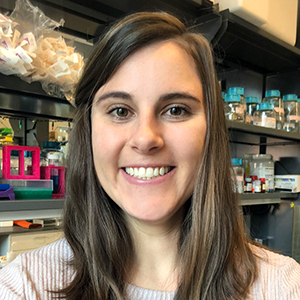JBC: How green tea affects cells
Green tea has been reported to have many effects on the body, from steadying blood sugar levels to preventing cancer. Yet reports delving into the scientific validity of these claims often have been paradoxical, with some proposing pronounced health benefits and others finding no correlation. A recent article in the Journal of Biological Chemistry from the lab of Chungho Kim of Korea University and Mark Ginsberg of the University of California, San Diego, partially explains why results may be inconsistent: The active ingredient of green tea can have multiple effects on transmembrane signaling, resulting in varied outcomes.
 Epigallocatechin gallate, or EGCG, is the bioactive ingredient of green tea. “EGCG has been reported to have complex and sometimes paradoxically opposing effects on many cellular signaling pathways,” Kim said. “However, the mechanisms underlying these effects have remained elusive.” Kim began studying the effects of EGCG during his postdoctoral research in the Ginsberg lab partially out of personal interest. “I grew up in a culture that says green tea can thin the blood,” he said.
Epigallocatechin gallate, or EGCG, is the bioactive ingredient of green tea. “EGCG has been reported to have complex and sometimes paradoxically opposing effects on many cellular signaling pathways,” Kim said. “However, the mechanisms underlying these effects have remained elusive.” Kim began studying the effects of EGCG during his postdoctoral research in the Ginsberg lab partially out of personal interest. “I grew up in a culture that says green tea can thin the blood,” he said.
However, many of his initial experimental results were inconsistent and variable, making it difficult to understand the underlying mechanism through which EGCG acts.
Now an independent investigator, Kim has continued his research in collaboration with Feng Ye, a postdoctoral fellow in Ginsberg’s lab, by studying two representative transmembrane signaling receptors to investigate how EGCG induces cellular effects. The first, an adhesion receptor, is called platelet integrin alpha(IIb)beta(III). The second, the epidermal growth factor receptor, or EGFR, belongs to the tyrosine kinase class of receptors.
The researchers used agonists to analyze the activation of these receptors in the presence of EGCG. They observed different activation effects based on whether the receptor agonist was present or absent. “Our findings with prototypical integral membrane proteins show that EGCG-mediated modulation is unique: it can activate inactive receptors but inhibit activated receptors in a receptor-specific manner. It is working as a toggle switch of transmembrane signaling,” Kim explained.
EGCG has been shown to interact with membrane phospholipids. These interactions can alter characteristics of the lipid bilayer — by decreasing its thickness, for example. To test if EGCG–lipid interactions could explain the receptor activation results, Kim and Ginsberg used transmembrane embedding assays. “We were able to explain the paradoxical effects,” Ginsberg said, “by observing that EGCG induces changes in embedding of transmembrane domains and relating this to effects on cell signaling.
The team used the data from the model receptors to come up with a theory as to why EGCG has different cellular effects. Their embedding assay data show that EGCG can change the topologies of receptor transmembrane domains, meaning that the angle at which the domain is embedded in the lipid bilayer can be increased or decreased. This can activate the receptors. But for receptors with activation that requires a shift in transmembrane domains, EGCG can oppose the shift, which inhibits the receptors. This dual effect would explain why there are so many conflicting reports in the field about the effects of EGCG.
Kim predicts their findings may have an impact on human health. Green tea is consumed as both a beverage and in a medicinal capacity, especially in East Asian countries. Studies have suggested that EGCG or green tea may reduce the risk of developing some cancers and cardiovascular diseases. The research by Kim’s group helps provide better understanding of how green tea may be mediating these healthy effects. “We believe our understanding of the mode of action in EGCG on cellular signaling may enable further development and utilization of EGCG as a pharmaceutical compound,” Kim said.
Enjoy reading ASBMB Today?
Become a member to receive the print edition four times a year and the digital edition monthly.
Learn moreGet the latest from ASBMB Today
Enter your email address, and we’ll send you a weekly email with recent articles, interviews and more.
Latest in Science
Science highlights or most popular articles

Fueling healthier aging, connecting metabolism stress and time
Biochemist Melanie McReynolds investigates how metabolism and stress shape the aging process. Her research on NAD+, a molecule central to cellular energy, reveals how maintaining its balance could promote healthier, longer lives.

Mapping proteins, one side chain at a time
Roland Dunbrack Jr. will receive the ASBMB DeLano Award for Computational Biosciences at the ASBMB Annual Meeting, March 7–10, just outside of Washington, D.C.

Exploring the link between lipids and longevity
Meng Wang will present her work on metabolism and aging at the ASBMB Annual Meeting, March 7-10, just outside of Washington, D.C.

Defining a ‘crucial gatekeeper’ of lipid metabolism
George Carman receives the Herbert Tabor Research Award at the ASBMB Annual Meeting, March 7–10, just outside of Washington, D.C.

The science of staying strong
Muscles power every movement, but they also tell the story of aging itself. Scientists are uncovering how strength fades, why some species resist it and what lifestyle and molecular clues could help preserve muscle health for life.

Bacteriophage protein could make queso fresco safer
Researchers characterized the structure and function of PlyP100, a bacteriophage protein that shows promise as a food-safe antimicrobial for preventing Listeria monocytogenes growth in fresh cheeses.

